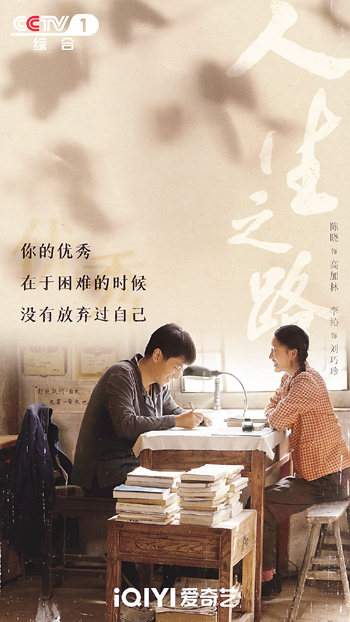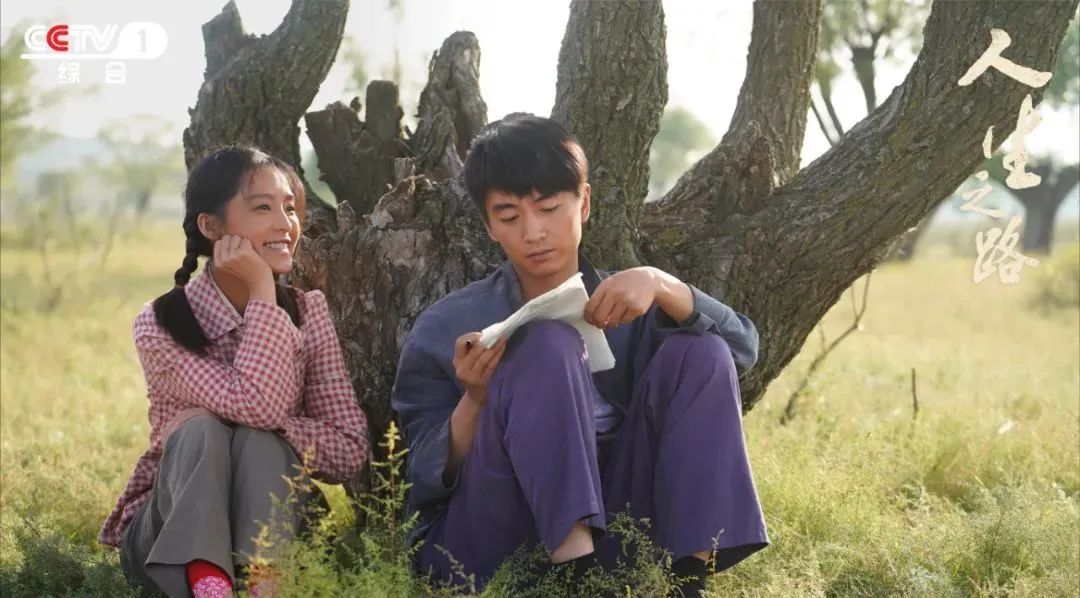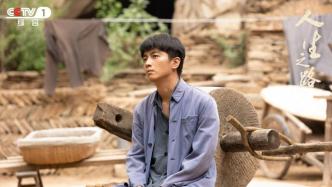
Directed by Yan Jiangang and starring Chen Xiao and Li Qin, the TV series "The Road to Life" was recently aired on CCTV. Part of the play is based on the classic novella "Life" written by Lu Yao, telling the story of a generation of rural youths struggling unremittingly in the conflict between personal ideals and reality. On the basis of retaining the spiritual core of the original work, "The Road to Life" gives full play to the artistic features and aesthetic advantages of the TV series, and continues to write the fate of major characters such as Gao Jialin and Liu Qiaozhen in line with the character of the characters and the logic of the development of the times. A vast space for intellectual discovery and aesthetic creation, from novellas to feature-length TV series.

"The Road to Life" poster
For the filming of classic literary works, audiences, creators, and critics have always had the requirement of "faithfulness to the original". One view is that the adaptation must not only be faithful to the theme and soul of the original work, but also must not change the main character settings, plot arrangements, and even detailed descriptions of the original work, so as to maintain the ideological and artistic integrity of the original work. It is required to "translate" the novel into an audio-visual language, and the adaptor needs to be a faithful "translator". And if you look at the history of China's film and television, you will find that those works that have been more successfully adapted and survived, such as "Blessing" adapted by Xia Yan, "Red Sorghum" directed by Zhang Yimou, "Old Well" directed by Wu Tianming, and "Old Well" directed by Pan Xiaoyang. "A Journey to the South" and "A Dream of Red Mansions" directed by Wang Fulin, etc., are all new aesthetic creations of the original works - "eating" and "digesting" the mountains of novel art cast by literary language, and melting them into untouched novels. The processing contains a lot of materials that sparkle with the sparks of the novel's ideological and artistic spirits, and then recast them into the mountains of art of movies and TV dramas with the unique aesthetic thinking and audio-visual language of film and television art. This leads to another point of view, that is, the adaptation should not only be faithful to the correct understanding and grasp of the theme and soul of the original work, but also be faithful to the special laws of film and television art, and also be faithful to the unique aesthetic advantages and authorship of film and television art. aesthetic style. Only in this way can the adaptor successfully complete the transformation from the original literary thinking of the novel to the audio-visual thinking of film and television art, thus becoming a qualified "creator standing on the shoulders of the novelist".

Stills of "The Road to Life"
The Road to Life takes the latter approach. Based on the protagonist Gao Jialin's character logic, life pursuit logic and the unique aesthetic advantages of long-form TV dramas, it adapts and continues the two aspects of Gao Jialin's fate in "Life" in keeping with the times.
One is to adjust and extend the narrative time and space of the original work. The time extends from the eve of the college entrance examination in 1984 to the entry of our country into the Internet era, and the space expands from rural areas and county towns in northern Shaanxi to the big city of Shanghai. The audience can not only see Gao Jialin's strong desire to "go out" in the background of the extremely scarce rural resources in the original work, as well as his life contradictions and life setbacks in a specific historical environment, but also see Gao Jialin's struggles in life. Under the background of more and more free urban and rural mobility in the new era, we seize the opportunity to move towards the vast world, and after going through hardships, we complete the "disenchantment" of the city that we have always dreamed of. Examine yourself and realize spiritual transformation and sublimation. This is based on Gao Jialin's self-improvement spiritual traits and character logic in the original work, a creative aesthetic imagination and reasonable extended fiction of his life path.
The second is to enrich the main narrative line of the original work, and add the major event of "replacing the college entrance examination" to Gao Jialin's life, thereby creating a dual-line narrative mode of Shanghai and rural areas in northern Shaanxi, opening up a high-level narrative for "The Road to Life". More parallel subspaces such as Jiagou, Madian Primary School, Shanghai Pujiang College, and urban construction sites also highlight the dramatic tension in which the fates of Gao Jialin and Gao Shuangxing mirror each other. This is based on the artistic characteristics of TV series that are good at spatial narrative and continuous narrative, and it fits the theme of the original work in a more dramatic way-"Although the road of life is long, there are only a few critical steps, especially when people are young." "Road of Life" fully mobilized the special means of expression of TV dramas, and expanded the limited content of novellas to the volume of long-form TV dramas according to its spiritual logic, thus enriching the historical connotation and deepening the theme.
On the basis of being faithful to the spirit of the original work and the artistic rules of TV dramas, the second half of "The Road to Life" embodies the creator's aesthetic ideal. For example, in the rewriting of Liu Qiaozhen's fate, Liu Qiaozhen in the novel abides by the virtues of industriousness, kindness, simplicity, and loyalty handed down by her ancestors in rural women, and has almost devout worship and unrequited love for the "educated Gao Jialin", while for My own ideals, ambitions, and spiritual pursuits are in a vague and insensitive state. The TV series boldly set a turning point in Liu Qiaozhen's fate, so that this "golden woman" in Shunde's grandfather's mouth was not trapped by Gao Jialin's abandonment. She came to Shanghai to work by chance, and struggled in the big city Re-establish your goals in life. This is where the creator intends to go beyond the novel "Life": focusing on showing the spiritual trajectory of rural women's awakening under the influence of the spirit of the times. At the same time, Liu Qiaozhen's character image also forms a "contrast" with Gao Jialin: on the one hand, Gao Jialin's growth is outward, gradually changing from focusing on his own ideals to caring for others, while Qiaozhen's growth is inward On the other hand, Qiaozhen's success also provides another path to Gao Jialin's "knowledge changes destiny", that is, hardworking hands, flexible mind, sincere Character can also change the destiny of rural youth.

Stills of "The Road to Life"
Another example is the description of Gao Shuangxing's life journey, which is also a new character and a new storyline discovered, picked, refined, and brewed by the creator from real life, which is also in line with the aesthetic spirit of the original work. The ending of Gao Shuangxing in "The Road of Life" and the ending of Gao Jialin in "Life" form a certain intertextual echo, that is, they both return to the countryside after losing their careers and love, and they both face life directly after "taking shortcuts and failing". Restart the journey. Whether it is Gao Jialin, Liu Qiaozhen or Gao Shuangxing, the main characters in the play show a kind of relief and never-ending forge ahead after experiencing various changes in life, just like Lu Yao's saying "Life is always like this, it cannot be called People are satisfied everywhere, but we still have to live passionately.” There are only a few critical steps in life, and the most important thing is to keep moving forward and persevere; there are no shortcuts in life, and you can’t step into the void, otherwise you will climb higher and fall deeper; life is impermanent, and things are always developing and changing. We must correctly understand ideals and Be realistic and cherish what you have now. This also demonstrates the creator's historical thinking, value judgment and deep understanding of the original work.
"Road of Life" is not limited to "faithful to the original", but strives to realize the creative path of combining the realistic spirit and romantic feelings of being faithful to the original, faithful to the correct understanding and accurate grasp of the spirit of the original, and faithful to the art. unique laws of form. It bravely stands on the shoulders of novelists to carry out aesthetic re-creation, reflecting the innovative development of transforming the literary thinking of novels into the audio-visual thinking of TV dramas. This is commendable.
(The author Zhong Chengxiang is a librarian of the Central Research Institute of Literature and History, and Lin Yuxiao is a lecturer of the Communication University of China. This article was originally published in the third edition of "China Art News" on March 31, 2023. The original title was: To Lu Yao's "Life "The innovative video continuation of "——Comment on the feature-length TV series "The Road to Life")


